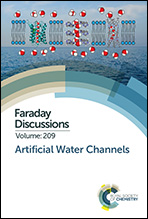2D graphene oxide channel for water transport
Abstract
Layer-stacked graphene oxide (GO) membranes, in which unique two-dimensional (2D) water channels are formed between two neighboring GO nanosheets, have demonstrated great potential for aqueous phase separation. Subjects of crucial importance are to fundamentally understand the interlayer spacing (i.e. channel height) of GO membranes in an aqueous environment, elucidate the mechanisms for water transport within such 2D channels, and precisely control the interlayer spacing to tune the membrane separation capability for targeted applications. In this investigation, we used an integrated quartz crystal mass balance (QCM-D) and ellipsometry to experimentally monitor the interlayer spacing of GO, reduced GO and crosslinked GO in aqueous solution and found that crosslinking can effectively prevent GO from swelling and precisely control the interlayer spacing. We then used molecular dynamics simulations to study the mass transport inside the 2D channels and proved that the chemical functional groups on the GO plane dramatically slow down water transport in the channels. Our findings on GO structure and water transport provide a necessary basis for further tailoring and optimizing the design and fabrication of GO membranes in various separation applications.

- This article is part of the themed collection: Artificial Water Channels


 Please wait while we load your content...
Please wait while we load your content...